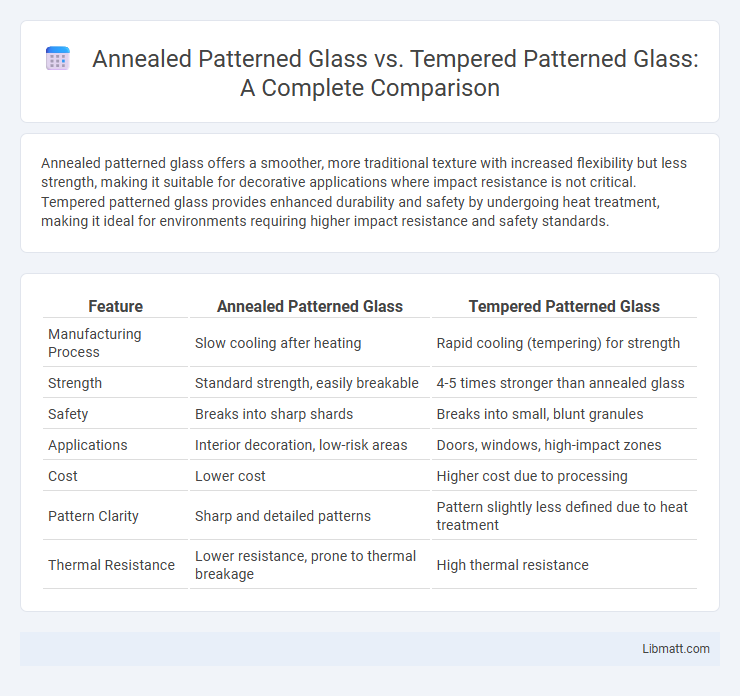Annealed patterned glass offers a smoother, more traditional texture with increased flexibility but less strength, making it suitable for decorative applications where impact resistance is not critical. Tempered patterned glass provides enhanced durability and safety by undergoing heat treatment, making it ideal for environments requiring higher impact resistance and safety standards.
Table of Comparison
| Feature | Annealed Patterned Glass | Tempered Patterned Glass |
|---|---|---|
| Manufacturing Process | Slow cooling after heating | Rapid cooling (tempering) for strength |
| Strength | Standard strength, easily breakable | 4-5 times stronger than annealed glass |
| Safety | Breaks into sharp shards | Breaks into small, blunt granules |
| Applications | Interior decoration, low-risk areas | Doors, windows, high-impact zones |
| Cost | Lower cost | Higher cost due to processing |
| Pattern Clarity | Sharp and detailed patterns | Pattern slightly less defined due to heat treatment |
| Thermal Resistance | Lower resistance, prone to thermal breakage | High thermal resistance |
Introduction to Patterned Glass
Patterned glass, characterized by its textured surface designs, enhances privacy and decorative appeal in architectural applications. Annealed patterned glass undergoes a controlled slow cooling process, offering easier cutting and shaping but lower strength and safety performance. Tempered patterned glass is heat-treated to increase strength by up to four times compared to annealed glass, providing superior durability and safety with a shatter-resistant fracture pattern.
What is Annealed Patterned Glass?
Annealed patterned glass is a type of glass that has undergone a slow cooling process after being heated, which reduces internal stresses and makes it easier to cut or shape. Featuring textured surfaces or patterns, it enhances privacy and aesthetic appeal in architectural applications without compromising clarity. Unlike tempered glass, annealed patterned glass is more prone to breaking into large, sharp shards upon impact.
What is Tempered Patterned Glass?
Tempered patterned glass is a type of safety glass that undergoes a heat treatment process, rapidly cooled to increase its strength compared to annealed patterned glass. This thermal tempering enhances the glass's resistance to impact and thermal stress, making it ideal for applications requiring higher durability and safety standards. When broken, tempered patterned glass shatters into small, blunt pieces, reducing the risk of injury.
Manufacturing Processes Compared
Annealed patterned glass undergoes a controlled slow cooling process after being formed, which relieves internal stresses but leaves the glass more prone to breakage. Tempered patterned glass is heated to approximately 620degC and then rapidly cooled through quenching, creating compressive surface stresses that enhance strength and safety. The key manufacturing difference lies in the rapid cooling stage of tempering, significantly increasing durability and impact resistance compared to the annealing process.
Strength and Durability Differences
Tempered patterned glass offers significantly higher strength and durability compared to annealed patterned glass due to its heat treatment process that increases resistance to impact and thermal stress. Annealed patterned glass, while aesthetically similar, is more prone to breakage and shattering under heavy loads or sudden temperature changes. For applications requiring enhanced safety and longevity, tempered patterned glass is the preferred choice.
Safety Features: Annealed vs Tempered
Annealed patterned glass is more prone to breakage and shatters into large, sharp shards, posing higher safety risks in case of impact. Tempered patterned glass undergoes a heat treatment process that strengthens the material and causes it to break into small, blunt pieces, significantly reducing injury hazards. Safety-conscious applications often prioritize tempered patterned glass for its superior impact resistance and safer fracture behavior.
Aesthetic and Design Considerations
Annealed patterned glass offers greater flexibility for intricate designs and can be cut, drilled, or altered after production, making it ideal for custom aesthetic applications. Tempered patterned glass provides a more uniform surface texture and enhanced safety but limits post-production modifications, influencing design choices toward simpler, more robust patterns. Your project's visual appeal and customization needs will guide the optimal selection between these two glass types.
Applications and Best Uses
Annealed patterned glass is ideal for interior applications such as decorative partitions, furniture, and cabinet doors where enhanced aesthetics and texture are important but impact resistance is less critical. Tempered patterned glass is best used in environments requiring greater safety and durability, including exterior facades, shower enclosures, and doors subject to higher stress or potential impact. Choosing between annealed and tempered patterned glass depends on balancing design preferences with safety regulations and load-bearing requirements.
Cost Comparison and Value
Annealed patterned glass is generally more cost-effective than tempered patterned glass due to its simpler manufacturing process, making it a budget-friendly option for decorative or non-safety applications. Tempered patterned glass offers higher strength and safety benefits, which justify its higher price point and provide greater long-term value in areas prone to impact or thermal stress. Your choice depends on balancing upfront cost savings with enhanced durability and safety requirements.
Choosing the Right Patterned Glass
Annealed patterned glass offers greater design flexibility and can be cut or drilled after production, making it ideal for decorative applications where intricate patterns are essential. Tempered patterned glass provides superior strength and safety due to its heat treatment, suitable for high-impact environments like doors or windows in commercial buildings. Selecting the right patterned glass depends on balancing the need for aesthetic detail with safety requirements and installation conditions.
Annealed patterned glass vs tempered patterned glass Infographic

 libmatt.com
libmatt.com